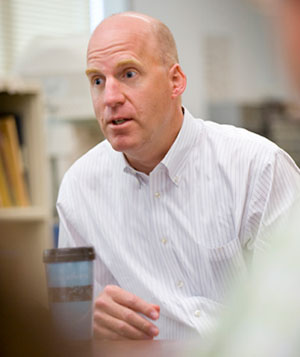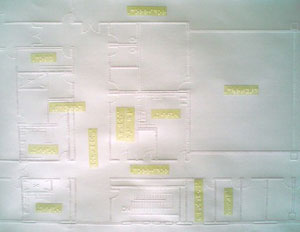When Bay Area architect Chris Downey lost his sight last year, he refused to consider a career change. Though surgery for a benign tumor near his optic nerve had left him blind, he returned to work just a month later. “I could hardly walk around,” says Downey, 46, who at the time was running a green modular-housing firm. But, he recalls thinking, “There’s something worthwhile if you can figure out how to do it.”

'You might pick a material that looks great, but so what? [That doesn't matter] if it doesn't feel good,' says Chris Downey

Image courtesy SmithGroup
Rendering for a Polytrauma and Blind Rehabilitation Center at the Palo Alto veterans’ hospital

Image courtesy SmithGroup
Tactile drawing printed with an embossing printer
A group called Access to Design Professions put him in touch with a blind architect in Lisbon, Carlos Mourão Pereira. The two began a lengthy correspondence, trading their experiences with tools like ink-free drawing kits. At work, Downey stuck to a managerial role, and he finished out the year. But in December he was laid off. He spent the holidays wondering, he says, “How does a blind architect—on top of that, a rookie blind architect—get a job in this economy?”
As luck would have it, a business coach he knew put him in touch with SmithGroup, which is collaborating with the Design Partnership on a 176,000-square-foot Polytrauma and Blind Rehabilitation Center for the Palo Alto veterans’ hospital. In March SmithGroup hired him as a contract architect.
In an interview with RECORD, Downey discussed how he goes about the “rather preposterous” venture of being a blind architect, and what architecture means when you can’t see it.
Lamar Clarkson: What defines good design for blind people? What are some of the ways you reach the other senses?
Chris Downey: Blind people can perceive quality design; they know if things are well organized. Sense of light, daylight coming through a window, it’s a nice thing if you’re sighted. If you’re blind, you can understand a space based on the movement of the sun. Tactile quality of materials—you might pick a material that looks great, but so what? [That doesn’t matter] if it doesn’t feel good. If it feels cheap, that’s not necessarily feeling like a very endearing place.
LC: Are there materials you like less now, ones that don’t feel so good?
CD: [Laughs.] We don’t go around feeling the building everywhere we go. But there are places where you can anticipate feeling, at a reception desk, in the stairwell, the handrail. Or even flooring materials—if you’re moving from one area to another and it feels different to a cane, then we’ll pick it up and know that that information can be critical.
LC: How do you go about doing your job on a day-to-day basis? What kinds of tools do you use?
CD: I haven’t been doing much physical modeling—I’d like to do more. What I’ve been doing is more creative direction. I came into this job after it was under way, so I’ve been spending a lot of time just trying to understand the building. I have an embossing printer that prints on a 16-inch-wide roll, and with any drawing created in AutoCAD or Revit, I can print that through this embossing printer. The act of reading those drawings is very different from reading drawings visually. It requires a lot more mental gymnastics to build that model in your head that you would otherwise just see in a flash. What I’d like to be able to do is to have a more dynamic role with the design. I can’t see anything on the screen; I have to print it to engage with it. It sort of slows down the interface.
LC: You’ve been working for a year since you lost your sight. Have you encountered any surprises in doing this discipline that’s so familiar to you in an unfamiliar way?
CD: Perhaps the biggest challenge of all is the mental exercise of keeping things organized in your brain, whether it’s the design of the space or the Excel document that holds the body of the program. In the end it comes down to, How do you maintain a relative understanding of all that data in a meaningful way?
LC: So you’re keeping a lot more data in your head.
CD: Yeah, you have to. It leads to, I think, a fairly acute mind, being able to juggle information stored in your brain. You’ve got to have it there at your easy disposal, as opposed to fumbling around looking for notes.
LC: What kinds of projects do you want to work on in the future? Any plans?
CD: It’s all very new. I started this year unemployed, and now I’m working on this incredible job. I’d like to work on other blind centers, blind schools, senior living centers. There’s a lot to be done with cities and university campuses. Art museums could use a lot of work, too, but that would be a bigger nut to crack. I would like to work on a museum that somehow manages to not have any signs that read Do Not Touch. Of course, I can always claim not to see them.

Post a comment to this article
Report Abusive Comment